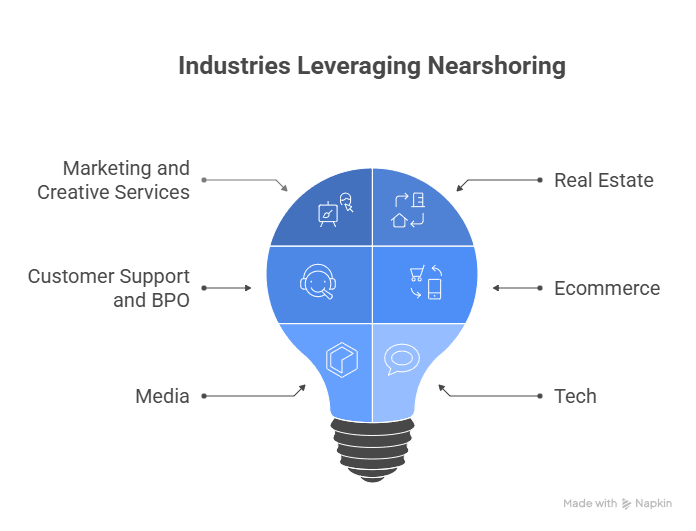Nearshoring has become a strategic solution for businesses seeking cost efficiency, improved collaboration, and access to skilled talent in nearby regions. By relocating operations or outsourcing tasks to neighboring countries, companies can streamline processes while maintaining cultural and time zone alignment. This approach is particularly effective in industries like technology, manufacturing, and customer support.
You might be wondering how nearshoring works in practice and what success looks like. From digital marketing hubs in Latin America to African professionals supporting sales campaigns for U.S. firms, real-world examples highlight the tangible benefits of this model.
In this text, you’ll explore some nearshoring use cases across various sectors. Whether you’re considering nearshoring for your business or simply curious about its impact, these stories will provide valuable insights into its potential advantages.
What Counts as Nearshoring?
Nearshoring involves relocating business operations, such as recruitment or production, to a nearby country. Unlike offshoring, which often spans continents, nearshoring focuses on geographic proximity for operational efficiency.
Geographic Proximity
You work with countries that share borders or are within the same region. For example, US companies often nearshore to Central America or Argentina due to their proximity and shared time zones.
Cultural Alignment
You benefit from similar workplace norms and communication styles. Shared cultural values reduce misunderstandings during collaboration.
Time Zone Compatibility
Your teams operate in overlapping hours, enabling real-time communication. This improves project management and reduces delays compared to offshore setups.
Skilled Talent Pools
You access qualified professionals without sourcing globally. For instance, Eastern Europe offers skilled developers for IT projects at competitive rates.
Cost Efficiency
You lower expenses by outsourcing tasks like manufacturing or customer support to regions with reduced labor costs but comparable quality standards.

Best Nearshoring Examples
Whirlpool
Whirlpool, the renowned home appliance giant, stands out for its longstanding nearshoring strategy in Mexico. Since 1987, Whirlpool has transferred major manufacturing and marketing operations to Mexico, where it currently operates multiple production facilities and distribution hubs. The strategic placement has enabled Whirlpool’s Mexican plants to export around 80% of their washers, stoves, refrigerators, and other household appliances to the United States and Canada.
Leveraging Mexico’s mature industrial infrastructure, the company has been able to streamline its supply chain, reduce shipping times, and achieve cost efficiencies in both labor and logistics.
Beyond manufacturing, Whirlpool expanded in Mexico by launching two technology centers focused on product development and innovation, taking advantage of the local pool of qualified engineers and technicians. The record investment in Mexico’s appliance sector surpassed $1 billion in new or expanded manufacturing plants in 2022, underlining the scale of Whirlpool’s commitment alongside other sector leaders.
Boeing
Boeing’s nearshoring initiatives center around the critical manufacturing of wiring and electrical systems for its commercial aircraft. In Mexico, Boeing partners with suppliers like Safran, whose Chihuahua-based facility produces 95% of the wiring assemblies for the Boeing 787 Dreamliner. The engineering center in Mexico also participates in designing wiring for the Airbus 1380, the world’s largest jetliner.
The proximity to the U.S. allows Boeing to realize shorter delivery cycles, enhance communication with the supply base, and ensure resilient logistics. Mexico’s skilled technical workforce and supportive trade environment continue to underpin Boeing’s operational success. The company’s strategic expansions include a 2020 announcement of a new production site dedicated to the interior components of its passenger aircraft.
Inditex (Zara)
Inditex, owner of fashion juggernaut Zara, harnesses nearshoring to support its just-in-time retail strategy. Approximately 10% of Zara’s clothing production is nearshored to Morocco and Turkey, regions selected for their cost advantages and close physical proximity to key European consumer markets.
The Moroccan and Turkish facilities allow Inditex to accelerate the supply process, reducing the cycle from design to retail shelf, and enabling Zara stores to refresh inventory more rapidly than competitors. This flexible supply chain approach is vital for responding to shifting fashion trends and maintaining Zara’s reputation for quick turnaround from runway to store.
Toyota
Toyota’s approach to nearshoring targets the Asian market’s unique demands and supply dynamics. The company maintains three manufacturing plants in Thailand and additional facilities in Indonesia, enabling Toyota to cut lead times, minimize shipping costs, and quickly adapt to local market requirements.
These facilities support efficient distribution throughout Southeast Asia, reinforcing Toyota’s regional competitiveness.
Localization of manufacturing has also enabled Toyota to respond more agilely to regulatory changes and market fluctuations within the ASEAN bloc. The company’s success has encouraged similar investments by other global auto makers in the region.
Volkswagen
Volkswagen (VW) leverages nearshoring by maintaining significant production operations in Mexico, a central strategy for efficiently serving North American markets. Its Mexican plants assemble key models for export to the United States and Canada, taking advantage of tariff-free access under the United States-Mexico-Canada Agreement (USMCA).
VW’s nearshoring move is driven by the desire to reduce logistical complexity, manage costs, and ensure production continuity amid global supply chain disruptions. The establishment of parts and vehicle assembly in Mexico has helped Volkswagen remain competitive and responsive to consumer demand in the region.
General Motors (GM)
General Motors operates a broad portfolio of nearshore auto manufacturing facilities in Mexico to support its North American supply chain. GM’s investment in Mexico has resulted in faster vehicle deliveries, reduced logistics expenses, and improved alignment with regional supply strategy.
The automotive giant also benefits from Mexico’s skilled workforce and supplier networks, allowing it to maintain high quality standards while managing production costs. GM’s recent expansions highlight the ongoing trend of major carmakers strengthening their nearshore operations.
Dell
Dell has strategically nearshored some operations to Brazil to provide better support for the Latin American market. This includes customer service, assembly, and logistics functions critical to regional responsiveness.
The move ensures that Dell can serve customers more efficiently, with improved delivery times and localized product offerings that meet specific market needs.
Cisco
Cisco nearshores its operations to Mexico and Costa Rica to achieve flexibility in supply chain management and access highly skilled networking equipment talent. The proximity to U.S. markets reduces transit times, and the talent pool enables Cisco to maintain product development and manufacturing standards seamlessly.
Microsoft
Microsoft invests in nearshoring operations in Mexico and Brazil, focusing on software development, customer support, and cloud services. These locations were chosen for their robust tech talent ecosystems and cultural compatibility with North American and Latin American clients. Nearshoring enables Microsoft to accelerate product cycles, support regional customers, and drive innovation from a strategically located base.
SAP
SAP operates nearshoring centers in Argentina and Mexico, where it assembles dedicated IT teams for software projects. The goal is faster turnaround times and cost-effective delivery using skilled developers fluent in multiple languages—a key for SAP’s extensive multinational customer base.
HP (Hewlett-Packard)
HP’s nearshoring move to Costa Rica provides access to a large, bilingual labor force that supports technical roles, customer service, and IT operations across the Americas. The Costa Rica hub helps Hewlett-Packard efficiently scale regional business processes.
Adobe
Adobe leverages nearshoring in Colombia and Brazil for its development hubs, combining technical and creative expertise with faster market adaptation. These centers enable the rollout of localized products and innovations addressing Latin American markets.
Parkdale Mills
The North Carolina-based textile producer Parkdale Mills opened a yarn-spinning facility in Honduras to simplify its supply chain, benefit from local trade incentives, and improve turnaround times for North American customers. This nearshoring model allows rapid response to demand fluctuations with high quality standards.
Fexco
Fexco, an Irish fintech, nearshores software modernization projects to Spain and Poland. The close proximity to Ireland and overlapping time zones enable Fexco to engage directly with development teams, resulting in better alignment and accelerated project timelines.
Comparis
The Swiss digital marketplace Comparis expanded development capacity by nearshoring React and .NET development teams to Spain and Poland. This strategy enabled Comparis to enhance integration, scale up quickly to meet changing business requirements, and maintain control over team quality and performance
Common Industries Using Nearshoring Strategies
Nearshoring supports businesses in scaling operations, accessing skilled talent, and optimizing recruitment processes. Many industries leverage nearshoring to streamline hiring, reduce costs, and improve service delivery.

Marketing and Creative Services
Recruiters source graphic designers, content creators, and digital marketers from nearshore locations with strong creative talent pools. Hiring managers assess candidates for expertise in tools like Adobe Suite or Google Analytics.
Agencies often onboard professionals from Latin America due to their cultural alignment and competitive rates. This approach reduces time-to-hire while maintaining high-quality output.
Real Estate
Real estate firms outsource administrative roles such as property listing management, data entry, and virtual assistance to nearshore teams. Staffing agencies vet candidates for organizational skills and CRM software proficiency (e.g., Salesforce).
CEOs delegate repetitive tasks to focus on strategic growth while retaining control over operational efficiency.
Customer Support and BPO
Customer support centers recruit bilingual agents from regions like Mexico or the Philippines for 24/7 coverage. Hiring managers screen applicants for communication skills during interviews.
Nearshore staffing agencies help companies fill customer service roles quickly by managing candidate shortlisting and onboarding processes.
Ecommerce
Ecommerce businesses contract IT specialists, inventory managers, and marketing experts through nearshore partnerships. Recruiters evaluate technical skills like Shopify development or SEO optimization before assigning roles. This strategy enables you to scale operations without increasing local labor costs.
Media
Media companies hire video editors, animators, and copywriters from countries with established creative industries such as Colombia or Egypt. Screening ensures candidates meet project-specific requirements like storytelling ability or editing speed. These hires allow production timelines to stay on track while reducing overhead expenses.
Tech
Tech firms deploy developers proficient in programming languages like Python or JavaScript by sourcing talent from Eastern Europe or South America.
Recruitment funnels include coding assessments followed by structured interviews conducted remotely. Nearshoring accelerates product development cycles while addressing skill shortages locally.
How Nearshoring Work with Some Industries (Examples)
Nearshoring drives operational efficiency across industries by leveraging skilled talent in nearby regions. These examples illustrate how businesses optimize recruitment processes and scale operations through nearshore staffing.
Tech Companies Nearshoring to Latin America
Tech companies source developers, QA engineers, and project managers from Latin America to address skill shortages.
Recruiters vet candidates for programming languages like Python, JavaScript, or PHP, ensuring technical alignment with project needs. Hiring managers benefit from time zone compatibility, enabling real-time collaboration during product development cycles.
For example, one of our clients, a US-based SaaS company, reduced hiring timelines by 40% after partnering with us to fill marketing roles.
Marketing Agencies Nearshoring to Eastern Europe
Marketing agencies recruit creative professionals such as graphic designers, content writers, and SEO specialists from Eastern Europe.
Candidates undergo skills assessments focused on design tools like Adobe Creative Suite or CMS platforms like WordPress before onboarding. CEOs prioritize this region due to competitive rates and high-quality output.
A digital marketing firm scaled its operations by outsourcing campaign management tasks to Egypt, achieving a 30% cost reduction while maintaining client satisfaction metrics.
E-commerce Nearshoring to Costa Rica for Sales Support
E-commerce brands hire bilingual customer support agents in Costa Rica to improve service delivery in English- and Spanish-speaking markets.
Staffing agencies screen applicants for communication skills and problem-solving abilities before assigning them roles in live chat or email support teams. Time zone overlap ensures faster response times during peak shopping hours.
An online retailer based in the US outsourced its Tier 1 support functions here, increasing first-response rates by 25% within six months.
Real Estate Firm Nearshoring to Argentina for Sales Support
Real estate firms delegate sales support tasks such as lead qualification and appointment scheduling to professionals in Argentina.
Recruiters evaluate candidates’ CRM proficiency (e.g., Salesforce) and interpersonal skills during interviews before finalizing hires. This approach allows hiring managers to focus on closing deals while offshore employees handle administrative workloads efficiently.
A Californian brokerage improved lead conversion rates by 20% after contracting an Argentinian team for prospect outreach activities.
Impact of Nearshoring: Before and After
Nearshoring transforms operational efficiency by improving delivery timelines, reducing costs, enhancing employee satisfaction, and accelerating revenue growth.
Below are key metrics that highlight these changes.
Delivery time improvements
Nearshoring accelerates project completion by aligning work hours with your core team. Recruiters source candidates from nearby regions where overlapping time zones enable real-time collaboration.
For example, hiring managers in the US who contract agile marketing professionals in Africa report faster sprint cycles due to synchronized schedules. This reduces delays caused by communication gaps often seen in other recruitment models.
Cost per resource
Nearshore staffing agencies help you recruit skilled professionals at competitive rates without compromising quality.
Hiring managers can assess talent pools in countries like Colombia or Poland, where salaries for engineers or customer support agents are 30-50% lower than in domestic markets. By outsourcing roles such as software development or administrative support to nearshore teams, CEOs optimize budgets while maintaining high output standards.
Employee satisfaction (internal + outsourced)
Cultural alignment improves engagement among internal teams and nearshore hires. Employees experience fewer misunderstandings during cross-team collaborations when recruiters prioritize cultural compatibility during screening processes.
Candidates sourced from culturally similar regions adapt quickly during onboarding, fostering stronger working relationships. For instance, bilingual customer service agents hired from Costa Rica deliver seamless interactions for US-based clients.
Revenue lift from faster time-to-market
Faster recruitment cycles directly impact product launches and service rollouts. Nearshoring enables hiring managers to fill critical positions within weeks instead of months by accessing pre-vetted candidate pipelines through regional staffing partners.
Companies launching eCommerce platforms have reported a 20% increase in quarterly revenues after contracting UX designers and marketing specialists from Argentina who expedited campaign execution times.
Nearshoring Works. These Companies Already Knew That.
The smartest businesses don’t nearshore to save money, but to operate better. They shorten hiring cycles, improve collaboration, and access talent their competitors never reach.
It’s not complicated: teams in your time zone communicate faster, integrate easier, and perform at a higher level. While others waste time on bloated local hires or offshore teams stuck in misalignment, nearshoring companies are already moving ahead.
That’s where Scale Army comes in. We’re the nearshore staffing agency U.S. businesses call when they’re tired of delays, turnover, and excuses. We help you build teams that are available, accountable, and built for output, not overhead.
Still hiring the old way? That’s a decision your competitors are hoping you keep making.
Book a strategic call with Scale Army. Or keep settling for less.
Frequently Asked Questions
How does nearshoring differ from offshoring?
Nearshoring involves moving operations to nearby countries with similar time zones and cultures, while offshoring typically means outsourcing to faraway regions. Nearshoring offers better communication, faster project timelines, and fewer cultural barriers compared to traditional offshoring.
What industries benefit most from nearshoring?
Industries like technology, manufacturing, customer support, marketing, real estate, eCommerce, and media often benefit the most. These sectors leverage nearshore talent for cost savings, skilled labor access, and operational efficiency.
Why is nearshoring popular among US companies?
US companies favor nearshoring due to shared time zones with countries like Mexico or Canada. This ensures smoother communication and collaboration while reducing costs compared to domestic hiring.
What are the main advantages of nearshoring?
Key benefits include cost efficiency (30-50% lower rates), access to skilled professionals, faster recruitment cycles, cultural alignment for seamless teamwork, reduced delivery times, and enhanced employee satisfaction.
Can you provide examples of successful nearshoring?
Yes! Tech companies hire developers in Latin America for quicker project completion. Marketing agencies build nearshore marketing teams at competitive rates. E-commerce brands employ bilingual customer support agents in Costa Rica for better service delivery.
How does nearshoring improve operational efficiency?
Nearshoring aligns work hours with core teams’ schedules for faster sprints and fewer delays. It also reduces costs significantly while enhancing collaboration through cultural similarities and streamlined onboarding processes.
Is nearshore staffing more affordable than local hiring?
Yes! Nearshore staffing can reduce costs by 30-50% compared to domestic markets without compromising quality. Skilled professionals in regions like Latin America or Eastern Europe offer competitive rates.
How does cultural alignment help in nearshoring?
Cultural alignment fosters better understanding between teams by minimizing language barriers and miscommunication. This leads to smoother collaborations, quicker onboarding processes, higher employee engagement levels—and ultimately—better results.




